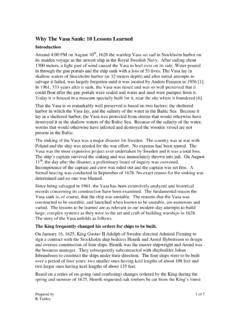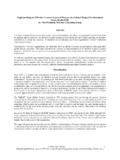Transcription of LEARNED HELPLESSNESS AND SCHOOL FAILURE – …
1 1 LEARNED HELPLESSNESS AND SCHOOL FAILURE Part I Why are so many children failing in SCHOOL ? What turns students off to SCHOOL and aborts learning in children of varying ability levels? Thirty years of research has yielded conclusive evidence that a LEARNED response is at the root of the problem. This research points to a need for a different perspective to find the solution. It makes clear that we have been neglecting the psychological reasons why students fail and refuse to learn despite the best efforts of educators to motivate and teach. The national report by the Commission on Reading describes these students as listless and inattentive and sometimes disruptive.
2 They do not complete work. They give up quickly when faced with a task that is difficult for them. They become anxious when they must read aloud or take a test. A good summary description is that they act as though they were helpless to do better. The report further states that this sense of HELPLESSNESS is affected in some subtle ways by parents and teachers behavior. As educators and parents, we most often see these children as passive and afraid to try. Effort to them seems futile, and they give up trying. These students develop self-defeating strategies that eventually lead to the very failures that they are attempting to avoid.
3 They strive for unattainable goals, they procrastinate, and they accomplish only tasks that require little effort. They are depressed, and a form of depression in children is anger. They feel that they are too stupid to learn so why try. These children have LEARNED HELPLESSNESS . The concept of LEARNED HELPLESSNESS unites educational and psychological research into a workable solution. It offers an answer to the frustration that is confronting the child, the parent, and the educator. Basically, LEARNED HELPLESSNESS creates three basic deficits in the child cognitive, emotional, and motivational which destroy the child s desire to learn.
4 The motivational deficit stops learning by aborting the child s initiation of responses. Too often we say the child is not trying, but research shows that these children have LEARNED to be helpless to learn. It is not a moral choice. The LEARNED helpless child believes he/she has no control over the learning process, and, after many failures, the child gives up trying because it hurts too much to try. It is a cognitive deficit in that it is a LEARNED conditioned response. Mere exposure to uncontrollability is not sufficient to make the child helpless, but the child comes to expect that FAILURE is inevitable.
5 In addition, in LEARNED helpless children there is cognitive debilitation and a decrease of logical perception and thinking. The emotional deficit leads to depression and lowered self-esteem. Depressed children may have problem behavior that they express through anger, aggression, running away, stealing, truancy, and other rebellious acts. LEARNED HELPLESSNESS is a conditioned response because it is LEARNED rather than rational. There was certainly nothing intrinsic in the sound of a bell that should have aroused the taste buds of Pavlov s dog.
6 It was a conditioned response, just as these children have a conditioned response to turn off after FAILURE . This LEARNED response or behavior operates to stop thinking processes in the same way as pulling the breaker switch or a power outage disrupts the electricity from getting to the lights in your house. Just as the power outage must be traced and repaired, so the source of children s FAILURE to learn must be understood and remediated or else no significant learning will take place. Children in this condition do not remain 2neutral but are actively developing maladaptive systems of responses to learning.
7 The longer the child is in this situation, the greater the number of times the child will have practiced inappropriate responses, day after day, year after year. Such children are building highly practiced inappropriate response systems. They cannot actively process their own way back to normal response patterns. They keep trying, the teacher keeps trying, but the response system is like a huge snake wrapped around the child or a ball of twine that gets more knotted with each effort to untie it. This becomes the child s habitual, automatic way of thinking, which is referred to as explanatory style by some psychologists.
8 Explanatory style is the manner in which you habitually explain to yourself why events happen. Remediation of LEARNED HELPLESSNESS is like a three-legged stool. All three legs are necessary to help the child. It is necessary, first, to adequately understand the components of LEARNED HELPLESSNESS to remediate it. Second, we must help children discover the root beliefs and the distorted perceptions they create that cause their self-defeating deficits. Third, we must give children the tools to change and refute their distorted beliefs and thereby reduce the deficits.
9 LEARNED HELPLESSNESS is a very different concept from what parents and educators are used to dealing with. However, because it centers on children s thinking as the basis for feelings and behavior, it is nonetheless powerful. Martin P. Seligman, the author of LEARNED Optimism (1990), says that The cure for LEARNED HELPLESSNESS is not the rediscovery of positive thinking. It does not consist in just learning to say positive things to yourself. Positive statements alone without first clearing out negatives have little if any effect. What is crucial is what you think, changing the destructive things you say to yourself when you fail or have setbacks and making these statements a part of your explanatory style.
10 Seligman says a person s explanatory style develops in childhood. By third grade, the child already has an optimistic or pessimistic style of looking at the world. This style has its roots in the mother s (or predominant parent s) explanatory style, but is shaped by criticism from parents, teachers, and other adults. It is also formed from negative life crises, such as death, divorce, and unresolved fighting in the family. What goes on in a child s life at home, in the community, and in SCHOOL has an effect on the child, for there is no neutral reaction.






